
Auntie Aggie cranes her neck, just to make sure she’s in shot while serving yet another customer at the NEWSFIELD stand. Oliver Frey sniggers in the background at Uncle David’s ‘Mean and Moody’ pose for the lens...

It was Showtime again in the first week of September, and off we all trotted to the Personal Computer World Show to person (or should that be Minion?) the Newsfield stand, potter round the show fearlessly seeking out the latest products for review, and generally have a good time meeting people.
Auntie Aggie was there, of course — never one to miss out on a picture, and over the weekend Oli Frey and David Western clambered down from the Artroom garret and wandered round Olympia soaking up the imagery.

Auntie Aggie cranes her neck, just to make sure she’s in shot while serving yet another customer at the NEWSFIELD stand. Oliver Frey sniggers in the background at Uncle David’s ‘Mean and Moody’ pose for the lens...
As ever, there was a roaring trade in backnumbers, shirts, caps and binders and the stand was packed to capacity — people even had to wait in the paddling pool to be served.
Paddling pool? Yes, paddling pool. The Girlie Challenge first laid down by Hannah Smith, our very own Girlie Tipster, escalated when C&VG Minions were spotted handing out rude stickers on Melissa’s behalf. Almost instantaneously, Hannah responded with her very own “Stop Raving Dame! Stand up Melissa and accept the Challenge” stickers, which soon adorned just about every visitor to the show. Oodles of green jelly and a paddling pool were shipped in specially, just in case Melissa made an appearance, but despite numerous enquiries to the C&VG stand she didn’t show. It seems that fictitious Tipster Melissa spent most of the PCW Show quaking in the Ladies — every time we asked where she was, we were told the dear girl was ‘powdering her nose’.
Which led to speculation that Melissa must have a very large nose indeed...
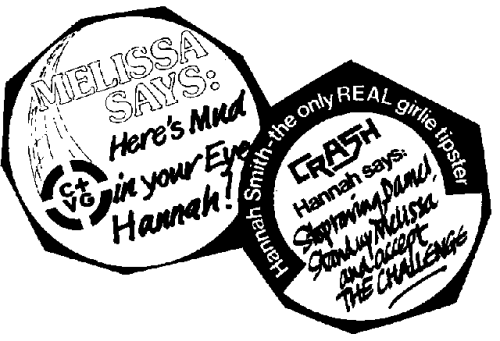
Japanese coin-op masters, Konami announced during the course of the PCW Show that they would be handling future conversions of their arcade games for the Spectrum, Amstrad and Commodore.
Following a series of highly successful releases licenced to Imagine, The Edge were granted the rights to Shao Lin’s Road which should be complete in time for a review next month. But from here on in, Konami games will be published for home micros by Konami.
First in line for conversion is Salamander, which has apparently been breaking coin-op records all over Europe, while Jail Break, Nemesis, Super Basketball and Iron Horse are just waiting their turn to arrive on the Spectrum.

Oh no! Not again. Greg Follis, on the FASTER THAN LIGHT stand realises that it’s five to ten in the morning and another hectic day at the PCW Show is about to begin...

Ace cartographer Kevin Payne collects his prize for producing the best map of Saboteur in the competition Durell hosted in the pages of CRASH. Tim Hine hands the Hi-Tech prize over as Kevin smiles sweetly for the camera. Ready to map Saboteur II now Kevin?
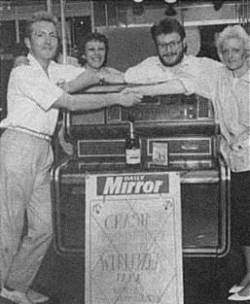
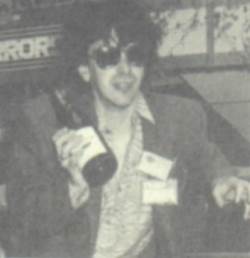
The champagne cork popped, the photographer’s bulb flashed and Tracey Robinson of Hove collected her prize in the Dynamite Dan II competition. What a high society celebration there was on Mirrorsoft’s stand at the PCW Show! Rod Bowkett the creator of Dynamite Dan came along specially to shake Tracey’s hand while Pat Bitten from Mirrorsoft looked on and our own beloved Editor Graeme Kidd hid his tatty Doc Martens from view. A civilised celebration indeed.
Then Hunter S Minson turned up — his finely attuned hearing perfectly capable of hearing a champagne cork pop over the 146 decibel background noise generated by the crowds. Everyone else had managed with paper cups, but not Hunter S...

The winners of the Rainbird Karting competition certainly had a good shopping trip with Tony Rainbird — his wallet contained £2,000 and he spent every penny!
Originally, the winners and their families were due to take a trial spin in Tony’s Kart at the Hoddesden Kart Club, but the heavens opened and rain stopped play as the sports writers say. So it was off to the Zip Kart showroom for copious advice before much examination of the price lists. Eventually the two winners managed to spend £1,000 each on the bits and pieces that are needed to put together a competition kart, and it was time to go for a celebration meal. Soon John Hirst and Alan Myers will be zooming around the track in their 100mph karts — once they’ve assembled the kit of parts they took home with them. Could prove a little tricky — there are no instructions!
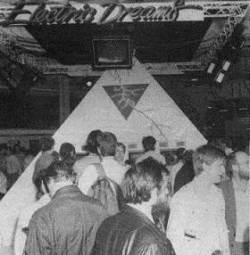
The ELECTRIC DREAMS pyramid was one of the strangest stands at the show. Inside the pyramid they sharpened razor blades and Mel Croucher demonstrated his new interactive video games to small, invited audiences

Laid bare, with its works there for all to see: the Spectrum Plus 2, a tidied up version of the 128. On the far left is the underside of the Datacorder, while heatsinks abound round the compact circuit board.
The Spectrum 128 is dead — long live the Spectrum 128 Plus Two!
Amstrad’s own version of the 128 sports a built-in tape drive, joystick sockets, and an improved keyboard. SIMON GOODWIN reports in depth on the revamped Spectrum.
Back in April, Amstrad’s boss Alan Sugar bought the rights to Sinclair Computers, promising a new Spectrum with a cassette drive “glued on” in good time for Christmas. That machine materialised at the Personal Computer World show on the 3rd September and should be on sale by the end of the month.
The machine is moulded in grey plastic and looks much cleaner because the old single-press keywords have vanished into the user manual, leaving only RUN, LOAD and CODE marked on the keys. Programming in 48K BASIC is going to be tricky unless you know the keyword positions off by heart; you will be better off using 128 BASIC, which is very similar but expects commands to be entered character by character. The manual says that 48K BASIC is ‘not recommended for anything other than a history lesson for the curious.’
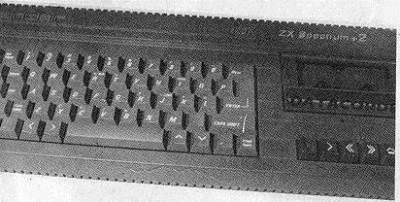
The Spectrum Plus 2 as it appeared on the Sinclair stand at the PCW Show. Note the cunning resemblance to the choccy cake we featured in TECH TIPS a little while ago...
The new keyboard is excellent; the only reason I can think that anyone might want to replace it is because there is still no semi-colon key between l and ENTER where touch typists expect to rest their right little finger. The ‘feel’ seemed fine on every machine I tested, although as usual for Amstrad there was some variation between individual computers. The wiring pattern is still an 8 by 5 grid, so add-on keyboards will work but I doubt that many people will feel the need for an up-grade even if they use the machine for several hours a day.
The cassette drive is very rudimentary. There is no auto-stop when you rewind or fast forward, so you may damage the motor or mechanism if you forget to press STOP.
Winding is very slow: it takes about a minute to rewind a C15 — 50% slower than the drive on the CPC 464. The tape pinchwheel is unusually small and will need regular cleaning. Sadly, there’s no tape counter.
A small hole allows access to the Azimuth alignment screw, so it should be possible to correct problems caused by minor knocks. The drive is held together with self-tapping screws, so you will probably have to replace the lot if anything serious goes wrong. There is no input for an external tape recorder, so any fault on the built in drive will force you to return the whole computer for repair.
Apart from the tape input, all of the Spectrum 128 sockets appear on the Spectrum Plus Two. There are telephone sockets for the keypad (apparently unavailable) and the combined RS232 MIDI output for serial printers or synthesizers. Any serial printer will work in 128 BASIC, although the COPY command expects one that recognises Epson quad-density bit image graphics. Printer control codes are ignored unless you use a couple of POKES — details in next month’s TECH TIPS.
There are sockets for RGB TTL, Composite Video and TV displays, plus a sound output socket which carries cassette tones, BEEP output and notes from the three-channel sound chip. Sound is also mixed into the TV signal, but there’s no built-in speaker and the sound output is much too weak to drive headphones without an amplifier.
Two joystick sockets on the left hand side of the machine can be read with IN 61438 and IN 63486 — the Interface 2 protocol. The sockets are standard nine pin ones, but they use a non-standard wiring arrangement. You can re-wire a normal stick to use that pin layout but you shouldn’t try to use a modified stick with other computers. One of the changed pins is used as a power source by other manufacturers, so a modified stick could short out the power supply!
A suitable joystick, the SJS1, is available as an option with the machine, along with six games. Prices are not fixed as I write, but should be around £150 for the machine, or £160 for the computer, stick and games. Rumour has it that Amstrad pay $2 for each joystick — the SJS1 is cheap and nasty, as are the bundled games — apparently so dire that they might as well be six blank tapes...
You would be wise to get the machine alone and pay £9 or £15 for a Cheetah 125 or Mach 1 joystick. Both have autofire, twin connectors — for the Plus Two or any other machine — and are much more durable than Amstrad’s offering. I particularly liked the Mach 1. Alternatively, get a standard stick and a Plus Two adaptor from Cheetah or Frel.
The new manual is the best yet, though it is a pity that it has been perfect bound like a paper back, rather than spiral bound. It consists of about 200 monochrome pages, with a good index. Most of the material comes form Stephen Vickers’ excellent orange manual for the original Spectrum, but Rupert Goodwin (from Sinclair) and Ivor Spital (from Amstrad) have added full details of the Spectrum 128’s add-ons without spoiling the overall style. There is lots of useful information about the 128 system and the new connectors, although a few more examples would have come in handy. Overall, though, it is a good reference guide and a helpful BASIC tutorial.
After much bowing and scraping, I persuaded Amstrad to let me dig around inside the machine — I also managed to sneak a copy of the ROM onto cassette, so I’ve got a pretty good idea how it all works. In essence, the Plus Two is a tidied version of the 128; the same ULAs form the basis of the system although they now sport heatsinks and Amstrad part numbers. The power regulator heatsink is inside the box, around the tape drive — it looks chunky enough to prevent overheating.
There’s a power indicator light and a reset button but no on-off switch. The edge-connector is recessed slightly more than previously, so you should check that add-ons will fit properly — most will connect up without problems, and Sinclair’s own Interface One is said to be fully compatible.
The Plus Two packs the 16K Interpreter and 16K Editor/RAM disk driver into one 32K ROM chip. The BASIC code differs from that of the original Spectrum in ten places. Most of the changes deal with the keypad and the paging mechanism for the Editor. As on the 128, 1K unused in the original ROM contains new code, this will screw up efficient programs that use Interrupt Mode 2 but most software houses are aware of this problem and can code around it. The other changes are localised and should not cause any incompatibility — for instance the machine announces that it is now ‘Copyright Amstrad’ rather than Sinclair Research, and the SAVE message asks you to ‘Press REC and PLAY’.
All in all this is an attractive up-grade for anyone who already owns a Spectrum. Unlike the 128, the Plus Two is here to stay.